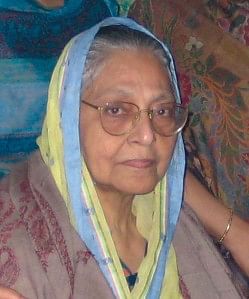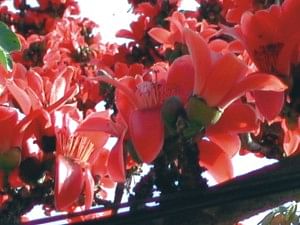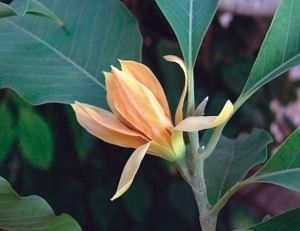|
Remembrance
Flowers from My Mother
Zareen Ahmed
 |
Umme Kulsum Siddiqua Huda |
Every spring, I wait in eager anticipation for the spectacular displays of pink weeping cherry flowers and white Bradford pear blossoms on the two trees in my suburban New Jersey yard. Although these particular trees are ubiquitous around our neighborhood, the understated beauty, grace and elegance of their delicate flowers is always captivating. Adding to their magic is their short-lived presence; the feathery flowers are blown away by the wind in a matter of days and we are left to wait another full year for their return. To me this annual ritual has an added significance. Having planted the trees in 1992 with my mother, Umme Kulsum Siddiqua Huda, the flowers are like recurring gifts from her.
To say that my mother was an avid gardener would be an understatement. She was both a master horticulturalist and an innovative landscape architect and the tropical paradise she designed in our house in Dhanmondi is a testament to her keen eye for style and her passion for gardening.
When our lake-side bungalow was built in the early sixties, she named the house “Shalmolee”, the Bengali name for the tropical tree Bombax ceiba. In South Asia, this deciduous tree is commonly known as the cotton tree or tree cotton and is characterised by spring blossoms of red flowers with five petals. The tree also produces a capsule, which when ripe opens to produce a white cotton-like fibre, hence the name. As the namesake for our house, my mother planted a beautiful Bombax ceiba tree in a corner immediately inside the front gate. The tree towered over the outer boundary walls and the beautiful red flowers that bloomed in spring were a delight to passers-by. Later in May, the cotton fibres would burst from the pods and we would “harvest” them to fill our cushions and pillows.
It was from my mother that I first heard the terms “pergola” and “espalier” as she researched her foreign magazine subscriptions and imported western gardening designs to her tropical landscapes. She designed three pergolas; two of the smaller ones were placed outside the bedroom windows and supported exotic Thai orchids and a Jade vine creeper my mother had collected from Malaysia. A third, large pergola was built over the car-port and framed the deep fuchsia bougainvillea that climbed up to the roof top and produced show-stopping blossoms every winter.
 |
Bombax ceiba |
The stairway leading to the roof-top of our single-story house was another show piece. Each of the cement stairs was cantilevered to produce a floating structure and hanging from each step was a clay pot containing a different variety of a tropical fern. The contrasting hues of the terra cota pots and the rich green ferns remain a topic of conversation till today.
In addition to roses, lilies, gardenias and other native plants that were abundant in our garden, my mother also experimented with introducing non-indigenous trees and shrubs to her tropical landscape: deep green avocados, yellow mimosas and crimson bottle brushes. Although some of these species have now been cultivated for tropical zones, in the sixties they were novelties in Bangladesh. She even experimented with azaleas and clematis but these did not survive the intense tropical heat.
Another of my mother’s favorite tropical flowers was the Michelia champaca. This native South Asian evergreen tree belongs to the magnolia family and although the yellow-golden flowers are not as large or showy as the more common white and pink magnolias, its fragrance is legendary. The Bengali name for the Michelia champaca is “Chanpa” and it is rumoured that this flower is the main olfactory ingredient in the commercial perfume, “JOY”. My mother did not have a chance to plant this species of magnolia but she had named her boutique store “Champak”, perhaps as a surrogate.
In conjunction with enhancing the aesthetic beauty of her beloved “Shalmolee” with her flowering plants, my mother also had the foresight to plant over 15 varieties of choice mangoes, jackfruit, guava, lime, cocoanut palms and several other varieties of fruit trees, each one selected and carefully planted at the right location needed for growth and later to afford shade. Forty years later, our family, friends and neighbours still enjoy the bumper harvests of these delicious fruits which she instructed should be distributed and shared.
 |
Michelia champaca |
As I moved from “Shalmolee”, Bangladesh to, coincidentally Cedar Court, New Jersey, it was only natural that I would need both my mother’s “green thumb” and her inspiration to grow my garden. During each of her visits, we would browse the plant and seed catalogues, visit garden centres and nurseries and plan the beds and corners where each shrub and tree would be planted. Over the years, my bare yard has been transformed by the daffodils, tulips and hyacinth bulbs we planted together in the fall, the pink blossoms of the disease-prone dog wood that my mother nurtured back to life, the golden-yellow hanging chains from the tree we bought from local garden centre, the crimson burning bush that does not fail to put on a show every fall and the vivid purple Jackamini clematis that vigorously climbs on my pergola. Although my mother was not in the US during some of the blooming seasons, she demanded detailed updates and photographs so she could vicariously enjoy their beauty.
We lost our dear mother on December 30, 2008, making the last two springs especially empty and lonely. My sister, Simeen, and brother, Najmul, are maintaining my mother’s tropical garden at “Shalmolee” and I must do the same for the garden she inspired in New Jersey. Last spring, as I cut some fresh daffodils and hyacinths from one of the beds we had planted together, I realised that as long as I cared from my garden, I could always enjoy these flowers as presents from my mother.
Besides the flowers growing in the garden, I am blessed with another intangible, yet permanent floral gift from my mother. The nick name my mother chose for me was “Chanpa”, a flower that we did not plant in “Shalmolee” or in my New Jersey garden, but one that she nurtured in her heart.
Copyright
(R) thedailystar.net 2010 |
| |
